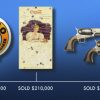Firearms collectors are a special sort of people. There are different things which motivate them, and once you understand some things about yourself, this may help you prioritize your acquisitions.
My bottom line up front advice is: When you are seeking a rare piece, whether it is rare because a small number of units were manufactured, or rare because the condition is superior, or rare because of some historical provenance, it is better to reach a little deeper, extend a little further and get it, instead of wishing in the future you had.
Right now in the collector’s market some of the very best and rarest specimens of their kind are appearing on the market for sale. It does not matter which genre of firearms is your particular interest, there are some “old-time” collections being sold. An alert, discerning, and active collector can take advantage of the opportunities which are surfacing.
First advice, know yourself and what you want most. Try to focus yourself. Many collectors, myself among them, have progressed through different stages of collecting, often changing focus of genre’s over time. One may start off with collecting each model of Winchester level action model, or perhaps one of each barrel length of the Colt Single Action Army Revolver in .45 long colt, or perhaps one of each model and caliber of pre-1962 Ruger revolver. These are examples of a changing focus, often as a result of either fulfilling the goal of one genre, or of simply changing one’s interest, often incidental to when one changes the other fellow collectors one associates with.
The trouble is, with multiple focuses all competing at the same time, this represents an increased demand on limited financial resources, or otherwise the space to put one’s acquisitions into.
Just as a long journey starts with a single step, so should collecting start the same way. Before you start going somewhere, you need to know where you want to go. Try to do this. Read books on the subject of the firearms you have an interest in, or go online and search. Become informed as to what is out there. You can call this auction company and ask to talk to a specialist in a particular genre. This specialist can help guide you, even to include recommending what books to read to start.
When I talk to a collector who has an interest in a gun, let’s say a German WW2 MP-40 machine gun, I need to find out if they primarily want to shoot it at the range, or if they are more interested in a collector’s piece. The reason is that a “shooter’s gun can be a more recently manufactured “registered tube” gun, as opposed to a gun in which the receiver was made during WW2 in Germany. These “tube” guns cost generally several thousand less than a commensurate condition “all-original” specimen.
Another question I ask is if the prospective buyer is interested in purchasing and re-activating a machine gun which has been Deactivated as a War Trophy or otherwise known as a “DEWAT” in machine gun circles. Normally a “DEWAT” gun is one in which the chamber has been plugged, either with weld, or lead, or some other substance so a cartridge cannot be inserted. Depending on how far the deactivation went, and the model of the gun, the barrel may have been welded in place to prevent it easily being replaced with another which was in a serviceable state. The bolt also, may, or may not have been altered, either through grinding off the face, or the extractor; or melting some of it away through welding.
Deactivated machine guns which are registered for private ownership have their own sub-set of interested potential buyers. Since the deactivated guns are “non-starters” for many advanced collectors who want, “only the best” in their collections, or for collectors/shooters who do not want to delve into the world of seeking replacement parts and finding competent (and timely) machine gun gunsmiths, the deactivated machine gun generally bring less money than “live” guns. But, that said, the competition at auction for deactivated machine guns can be quite lively, even to the point where DEWAT guns can realize prices into the territory of their fully operational brethren. One may ask, “how does this happen?”
The answer is, that although the machine gun collecting community is relatively small, many who are in it have purchased parts over the years in the hopes of finding a deactivated gun, or otherwise a registered receiver to put the parts they already have onto. For these forward-thinking collectors, they want to realize their investment in terms of taking the parts they already have spent money on, and making an otherwise deactivated gun into a live, operational, and often quite collectible specimen.
There are also the plain, flat-out speculators who may not have the parts needed to repair/reactivate a gun, but figure if they can acquire the DEWAT gun at a reasonable price, then they can seek/acquire the necessary parts, pay for the cost of labor to repair/reactivate the gun, and then once the work is completed, sell the gun for a reasonable profit.
There are also deactivated guns out there which are of models sufficiently scarce as registered specimens of their kind that the advanced collector who has been searching for that model, sometimes for years, is willing to dig very deep to get it, because the opportunity to find another, especially live and operational, may not surface for years, if at all. Case in point was a deactivated rare first model German FG-42 machine gun which recently sold at Julia’s auction. Public offering for sale of a first model FG-42 was unheard of, and with so few specimens registered for private ownership, the winning bidder knew that this was probably their only opportunity to add one to their collection.
This writer has been fond of saying, “One can always go out and earn more money, but for certain guns, the opportunity to get that model in that condition is NOT likely to happen again for another 30 years.” For many of us, 30 years means not likely to occur again in our lifetime.
It is a good feeling to “get” that particular piece which one has been seeking. The pain of spending the $$ to get it fades over time, particularly as inflation occurs over the years. The gun purchased for, “a little too much” a few years ago seems like pretty nice bargain in today’s world. Just ask an older collector.
John Keene is a specialist in historical automatic arms. Past articles include “What to Consider When Buying A Machine Gun” in three parts.


